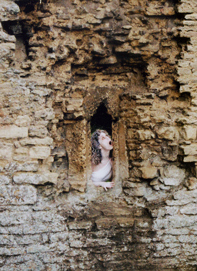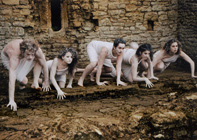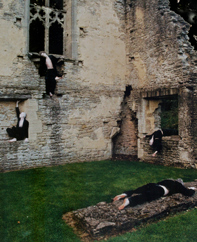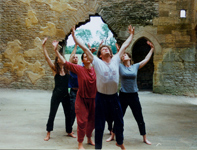
» café reason
» butoh
» diary
» new work
» past work
THEATRE WORK
SITE SPECIFIC WORK
»» landscape retreats
»» living library
»» botanic garden
»» tate modern
»» the forest that-
»» -sailed away
»» millennium walks
» classes
» contacts

Entrance (Ayala)

Stone spirits (Jules, Amy,
Jeannie, Bizia, Lee, Ayala)

Finale (Lee, Jules, Jeannie, Amy)

Rehearsing Le Bateau Ivre
THE FOREST THAT SAILED AWAY
(September 2000)
"If there is one water...that I long for, it is that
dark, still pool where, into the scented twilight,
a child crouching full of sadness, launches
a boat as fragile as a butterfly in May".
(Arthur Rimbaud Le Bateau Ivre)
This outdoor performance was the end result of a two-year cross-artform project, run by Coral Arts and set in the ruins of Minster Lovell Hall.
Combining poetry, dance, music and song, shadow puppets and storytelling, it focused on the story of the Wychwood Forest, which once surrounded the Hall and extended over much of west Oxfordshire. Over the centuries the forest has been gradually felled, and now only small patches remain. One of the main historical uses of the wood was to build the sailing ships that were needed to discover and conquer new worlds, to trade and to fight. The Forest That Sailed Away is the story of those trees, of journeys of exploration and of returning.
There are also stories concerning the Hall itself: of the first Viscount Lovell who, during the Wars of the Roses, hid from his enemies in a secret, sealed chamber, only to perish in it when the servant caring for him died; and of the unfortunate young bride who, during a game of hide-and-seek at her wedding feast, hid rather too well within an oak chest and was not found until years later - their ghosts are said to haunt the ruins, crying for release.
The story of the Wychwood forest was told in poetry and song through the characters of a ship's figurehead, a sea-captain (representing Everyman) and a cabin boy (representing youth and the future), accompanied by a chorus of trees and ships. Café Reason chose to bring into the mix the spirits of the ruined stone walls, of the empty halls and shadowed niches - not following the narrative but weaving in and out of it memories, dreams, and visions. They also danced the ghosts of drowned sailors longing for home, and this sequence, Le Bateau Ivre, (The Drunken Boat) also formed part of their Erosion show in 1999.